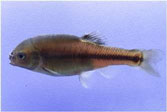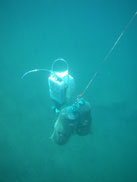AOP-based effects monitoring and exposure reconstruction
Description/Rationale and Research Approach:
This task focuses on the application of pathway-based effects data (e.g., omic tools, medium- and high-throughput in vitro methods, and in vivo biomarkers), in conjunction with knowledge of adverse outcome pathways (AOPs), for effects-based monitoring and exposure reconstruction. Pathway-based effects data can complement the analytical monitoring tools used historically by EPA and thus aid Program Offices and Regions in addressing situations in which: (1) unknown (and hence unmeasured) chemicals may be responsible for adverse biological effects; (2) analytical detection limits may be inadequate with respect to biological effects, such as when transient exposures occur (i.e., the chemical is no longer present at detectable levels) that produce lasting biological effects; and (3) biological effects result from aggregate exposures (i.e., chemical mixtures). Anticipated applications of this research include monitoring impacted ecosystems such as Great Lakes Areas of Concern and assessing the progress of remediation efforts, particularly where the chemical(s) responsible for adverse effects are unknown or no longer detectable. In addition, since direct measure of exposure to environmental contaminants in real time (i.e., as the exposure is occurring) is rare and difficult to conduct, ORD clients are frequently faced with diagnosing or reconstructing past exposures and establishing sufficient credible evidence to support criminal investigations and enforcement actions. This task is aimed at the development of effects-based monitoring tools and methods that support such applications.
There are many “chemicals of emerging concern” (CECs) which are defined as such either because sensitive and specific analytical methods for detecting their occurrence in the environment or concerns over the types of effects they may cause have only recently emerged. Examples include potentially endocrine-active chemicals, pharmaceuticals and personal care products, flame retardants, perfluorinated chemicals, and presumably others yet to be identified. Application of quantitative structure activity relationships, high throughput toxicity pathway-based in vitro assays, genomics and other “21st century” toxicity testing tools have the potential to provide hazard information for vast libraries of chemicals in a relatively rapid and cost effective manner. However, use of that information in risk assessment necessitates that complementary exposure information is available. Furthermore, in the context of sustainability, it also necessitates that exposures are considered not in isolation, but rather in aggregate.
Exposure assessment has classically relied on instrumental and analytical monitoring of specific chemicals of concern. However, there are some well recognized limitations to these approaches relative to management/monitoring of large inventories of potential environmental contaminants as well as their associated degradates and metabolites. Among these limitations are those instances where “unknown” (and hence unmeasured) chemicals are responsible for adverse biological effects or when analytical detection limits may be inadequate with respect to biological effects. Additionally, uncertainty exists regarding the possible biological effects of complex chemical mixtures. Past regulatory/monitoring efforts have recognized these drawbacks and addressed them through the use of biological effects-based testing to complement chemical analyses. For example, almost 20 years ago, the National Pollution Discharge Elimination System (NPDES) permitting program administered under the auspices of the Clean Water Act started to incorporate acute or chronic toxicity (e.g., effects on survival, growth, reproduction) limits into effluent permits. However, the types of methods and apical endpoints considered in such testing are inadequate to detect a range of effects of concern in 21st century risk assessments, including a variety of sublethal effects, potentially long-term or multi-generational effects, effects specific to sensitive subpopulations or life stages, etc. Consequently, there is a need for pathway-based effects monitoring approaches that employ the types of non-standard endpoints (e.g., targeted molecular and biochemical measurements anchored to specific toxicity/adverse outcome pathways; omics) currently being considered for hazard assessment and screening of individual chemicals. The intent would be to leverage the power of pathway-based effects monitoring to “cast a broader net” than could be cost-effectively achieved using analytical methods, while at the same time increasing the specificity of the information associated with the effects data. Rather than simply identifying a non-specific toxic outcome, effects would be more directly anchored to specific molecular initiating events and an associated knowledge-base regarding the types of chemical structures able to cause the initiating molecular interaction, with much of that knowledge-base emanating from CSS research.
In response to this need, this task aims to use a series of case studies that consider various exposure scenarios of relevance to Program Offices and Regions to demonstrate and develop the utility of effects-based data for monitoring and exposure reconstruction. Specifically, Product 1 will utilize pathway-based effects data collected from fish exposed in situ, as well as in the laboratory, to waste-water treatment plant discharges and/or agricultural runoff. These data will be interpreted in the context of analytical characterization of surface water contaminants at the same sites. This will provide a means to develop/evaluate the use of pathway-based effects tools for site characterization by using input regarding known contaminants at the sites as a first step in the progression of this approach.
Further development/evaluation of pathway-based effects approaches will focus on the use of specific omics data (i.e., transcriptomics and metabolomics) with appropriate bioinformatic methods in order to assess progress of remediation efforts within Great Lakes Areas of Concern (Product 2) in support of the GLRI (high priority for GLNPO/Region 5). These omics technologies have been found to be particularly sensitive with respect to temporal changes occurring in impacted organisms, potentially allowing the nature and severity of impairment to be tracked over the duration of remediation efforts. Similar to Product 1, this product will involve the use of fish deployed to selected sites. Site selection will be carried out in coordination with input from GLNPO/Region 5. Case studies associated with Product 2 will serve to inform the development of recommendations regarding the use of omics for effects-based monitoring in aquatic environments.
Mechanism based in vitro bioassays represent another type of biological effects-based tool that can be used to screen environmental samples for specific types of biological activity linked to adverse outcomes of concern. As such, assays are automated for high throughput using robotics and computational approaches; they offer a means to characterize effects of environmental samples in an efficient and cost effective manner while reducing animal use. However, in order to properly develop and apply these methods, determination of best practices for preparation of environmental samples for in vitro exposures is necessary. Product 3 will respond to this need by testing/validating various methods for collection, storage, and transportation of surface waters from selected sites. Similar to Products 1 and 2, case studies aligned with high priorities to the Program Offices and Regions will be selected.
While research aligned with Products 1-3 will focus largely on effect-based monitoring, research associated with Products 4 and 5 focus on exposure reconstruction applications including determination of the causal agents in complex mixtures. Specifically, Product 4 will employ laboratory-controlled case studies to evaluate whether pathway perturbation motifs (patterns of biological response) are conserved for individual chemicals when those chemicals are present in complex mixtures. The results of this approach will aid assessment of feasibility, optimization of analytical approaches, and facilitate development of recommendations regarding the use of pathway-based approaches (including omics) for assessing exposures to multiple stressors.
While Product 4 utilizes a controlled laboratory setting to test specific hypotheses and assumptions underlying the use of pathway-based tools for identifying causal agents in complex mixtures and exposure reconstruction, Product 5 will aim at applying these approaches for various surface waters including the Great Lakes (high priority for GLNPO/Region 5), arid western rivers (high priority for Region 8), or heavily impacted eastern receiving waters known to produce significant adverse effects in fish such as increased incidence of the intersex condition (high priority for Region 3). The aim of these case studies will be to develop and optimize pathway-based exposure reconstruction methods for real world environments. Such tools would assist Program Offices such as The National Enforcement and Investigation Center (NEIC) and the Regions in reconstructing past exposures. Information of this nature may be critical when conducting criminal investigations and for supporting enforcement actions where both the identification of the causal agent and the establishment of a timeline of events are required.
Finally, it is recognized that potential population and ecosystem-level impacts are the primary drivers of ecological risk management decisions. Therefore, a portion of this task will focus on utilizing effects-based monitoring data as a basis for forecasting potential population impacts. Specifically, product 6 focuses on the development of a model construct for forecasting changes in fish population status using pathway-based effects data anchored to key events in reproductive adverse outcome pathways.
MED Scientists:
Joseph Tietge
Michael Kahl
Kathleen Jensen
Gerald Ankley
Daniel Villeneuve
Carlie Lalone
David Miller
Publications:
Berninger, J.P., D. Martinovic-Weigelt, N. Garcia-Reyero, Perkins Edward J, Ankley Gerald T, and D.L. Villeneuve. Using transcriptomic tools to evaluate biological effects across effluent gradients at a diverse set of study sites in Minnesota, USA. Environmental Science & Technology (in press).
Ekman D.R., Ankley G.T., Blazer V.S., Collette T.W., Garcia-Reyero N., Iwanowicz L.R., Jorgenson Z.G., Lee K.E., Mazik P.M., Miller D.H., Perkins E.J., Smith E.T., Tietge J.E., Villeneuve D.L. Biological effect-based tools for monitoring impacted surface waters in the Great Lakes: a multi-agency program in support of the GLRI. Environmental Practices (in press).
Feswick, A., G.T. Ankley, N. Denslow, L.E. Ellestad, M. Fuzzen, K. Jensen, K. Kroll, A. Lister, D.L. MacLatchy, M.E. McMaster, E.F. Orlando, M.R. Servos, G.R. Tetreault, M.R. Van Den Heuvel, and K.R. Munkittrick. An inter-laboratory study on the variability in measured concentrations of 17β-estradiol, testosterone and 11-ketotestosterone in white sucker: implications and recommendations. Environmental Toxicology and Chemistry (in press).
Martinović-Weigelt, D., A.C. Mehinto, G.T. Ankley, N.D. Denslow, L.B. Barber, K.E. Lee, R. King, H.L. Schoenfuss, and D.L. Villeneuve. Transcriptomic-based effects monitoring for endocrine active chemicals: Assessing relative contribution of treated wastewater to downstream pollution. Environmental Science &Technology (in press).
Davis J.M., Collette T.W., Villeneuve D.L., Cavallin J.E., Teng Q., Jensen K.M., Kahl M.D., Mayasich J.M., Ankley G.T., Ekman D.R. 2013. Field-based approach for assessing the impact of treated pulp and paper mill effluent on endogenous metabolites of fathead minnows (Pimephales promelas). Environmental Science & Technology 47:10628-10636.
Miller, D.H., J.E. Tietge, M.E. McMaster, K.R. Munkittrick, X. Xia, and G.T. Ankley. 2013. Assessment of status of white sucker (Catostomus commersoni) populations exposed to bleached kraft pulp mill effluent. Environmental Toxicology and Chemistry 32:1592-1603.
Martinovic-Weigelt, D., D.R. Ekman, D.L. Villeneuve, C.M. James, Q. Teng, T.W. Collette, G.T. Ankley. 2012. Fishy aroma of social status: Urinary chemo-signaling of territoriality in male fathead minnows (Pimephales promelas). PLOS One 7:46579.
Wehmas, L.C., J.E. Cavallin, E.J. Durhan, M.D. Kahl, D. Martinovic, J. Mayasich, T. Tuominen, D.L. Villeneuve, and G.T. Ankley. 2011. Screening complex effluents for estrogenic activity with the T47D-Kbluc cell bioassay: Assay optimization and comparison to in vivo responses in fish. Environmental Toxicology and Chemistry 30:439-445.
Blake, L.S., J.E. Cavallin, D. Martinovic, L.E. Gray Jr, V.S. Wilson, R.R. Regal, D.L. Villeneuve, and G.T. Ankley. 2010. Characterization of the androgen-sensitive MDA-kb2 cell line for assessing complex environmental mixtures. Environmental Toxicology and Chemistry 29:1367-1376.
Expected Products:
Date |
Product |
Contact |
Sep 30, 2014 |
(6) Linking to population impacts: A model construct that can be used to forecast changes in fish population status based on effects-based monitoring data (e.g., plasma steroid or vitellogenin concentrations) anchored to key events in reproductive adverse outcome pathways. |
David Miller |
| Sep 30, 2014 | (3) Surface water sample collection/preparation: Best practices for preparation of surface water samples for in vitro analyses using pathway-based assays, including high throughput assays. | Gerald Ankley |
![[logo] US EPA](../gif/logo_epaseal.gif)


